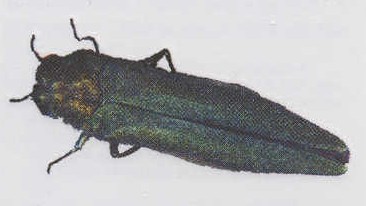The emerald ash borer (EAB) was first detected in European Russia in 2003, in Moscow. By 2020, EAB was recorded in 16 provinces [=‘oblast’] of European Russia, especially to the West of Moscow towards the borders with Belarus and Ukraine.
Russian scientists have documented that the emerald ash borer is spreading faster in the southwest of the country and in neighboring Ukraine than in the northwest (near St. Petersburg and the Baltic countries).
Despite an abundance of ash [both green ash (Fraxinus pennsylvanica) – native to North America – and European ash F. excelsior], EAB population density in the northwest remains low and damage is in scattered clusters.
However, in September 2020 officials detected an isolated outbreak in a St. Petersburg suburb, 520 km away from the apparent edge of the principal Russian population. The authors believe this outbreak has been present since 2015. They think it is the result of transport of EAB either by “insect-hitchhiking” on vehicles or by movement of plants for planting or other commodities.
The Petersburg population is only 130 km from Estonia and Finland – the border with the European Union.
A thousand kilometers to the south, in southwest Russian eastern Ukraine, an outbreak was reported in June 2019. By the next summer, EAB were detected more than 100 km to the West. While this outbreak is still 800 km from Ukraine’s border with eastern Europe (Poland, Slovakia, Hungary, Romania), the authors note that rapid spread is likely since F. excelsior and F. pennsylvanica have been extensively planted along roads, railways, field shelter belts, and urban greenings.
The slower spread in the North is attributed to colder temperatures, the local abundance of food, and possibly pressure by the native parasitoid Spathius polonicus Niezabitowski (note that USDA APHIS has approved two Spathius species as biocontrol agents in the U.S.). On the other hand, the climate is milder in Saint Petersburg (along the coast) than it is inland; and ash woodlands are common along the Baltic coast.
Noting that ash dieback (Hymenoscyphus fraxineus) has devastated more than 95% of European ash populations, the authors express concern about the future of ash.
SOURCE
Musolin, D.L.; Selikhovkin, A.V.; Peregudova, E.Y.; Popovichev, B.G.; Mandelshtam, M.Y.; Baranchikov, Y.N.; Vasaitis, R. North-Westward Expansion of the Invasive Range of Emerald Ash Borer, Agrilus planipennis Fairmaire (Coleoptera: Buprestidae) towards the EU: From Moscow to Saint Petersburg. Forests 2021, 12, 502. https://doi.org/10.3390/f12040502
Posted by Faith Campbell
We welcome comments that supplement or correct factual information, suggest new approaches, or promote thoughtful consideration. We post comments that disagree with us — but not those we judge to be not civil or inflammatory.
For a detailed discussion of the policies and practices that have allowed these pests to enter and spread – and that do not promote effective restoration strategies – review the Fading Forests report at http://treeimprovement.utk.edu/FadingForests.htm
